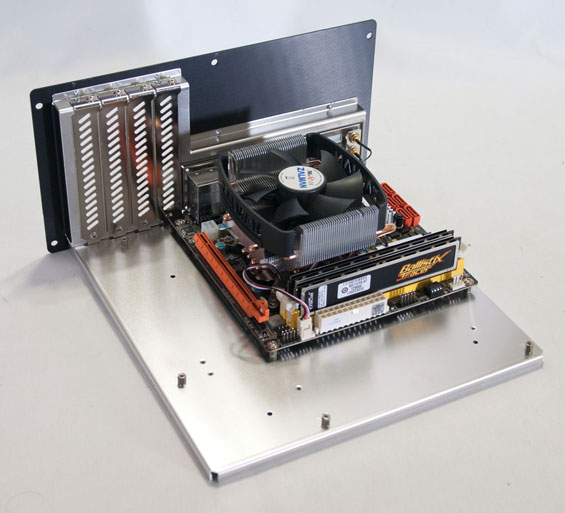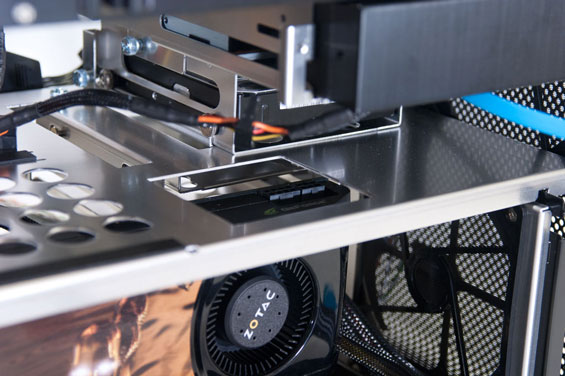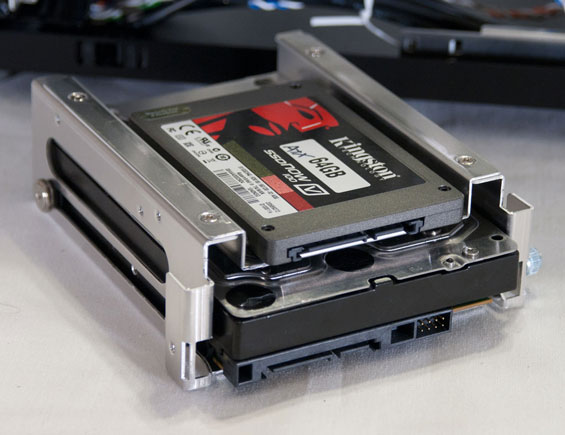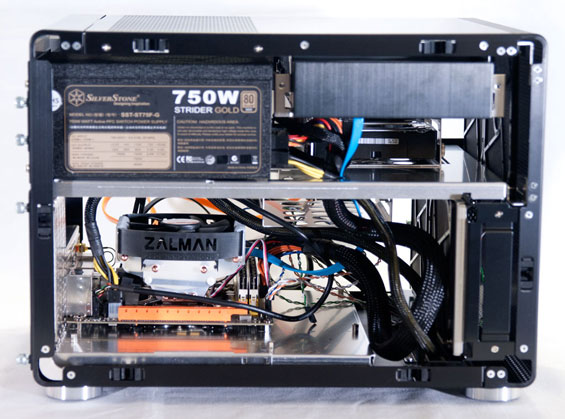Lian Li's PC-V353: Lighter Than Air
by Dustin Sklavos on September 28, 2011 4:30 AM EST- Posted in
- Cases/Cooling/PSUs
- MicroATX
- SFF
- Lian Li
- Mini-Tower
Assembling the Lian Li PC-V353
Lian Li designed the PC-V353's assembly to be tackled essentially in pieces. I have historically endorsed using modular power supplies for any build (to the point where I'm mortified whenever I have to assemble a machine without a modular power supply); in the instance of the PC-V353, I'm about 5% away from making it a requirement.
The PC-V353 breaks down into roughly four parts (five if you're going to argue semantics): the motherboard tray, the drive trays, the power supply mount, and the chassis (which includes the optical drive mount). Because of the nature of the breakdown, it's really in your best interests to wire up each part as best you can before fitting it all together. Since power leads are particularly ornery, that makes a modular power supply that much more vital to assembly in a case like this.

Since the motherboard tray is removable, that part was remarkably easy, though I found the relatively flimsy nature of the tray itself to be a little disconcerting. Everything did come together fine, but it's strange when you're reassuring yourself that it'll work because the rest of the case will have a little give. When I installed the GeForce GTX 580 on the tray, it looked absolutely massive.

Unfortunately, video cards with top-mounted power connectors are liable to be basically hosed when you do install them in the PC-V353, and that's the reason why there are no results for the GTX 580 in the thermal and acoustic testing: the card itself fit fine, but the power connectors were just too thick and there wasn't enough clearance. Lian Li has a cut-out in the top half of the case for routing exactly these power cables, but it didn't line up with our GTX 580, which uses NVIDIA's reference design.

The drives all install in a fairly unique way as well: all of the screws are on rubber-lined runners, and this is true for the 2.5", 3.5" and 5.25" drive mounts. Screws are mounted into the drive first, and then for the 3.5" drive, the drive slides into the rails, and then a thumbscrew locks it into place. Instead of a thumbscrew for the 5.25" drive, it's the fascia. And for the 2.5" drive, there are basically four big holes you drop the screw side into, then push the drive "up" and it locks into place. The system is really quite clever. Again, though, you'll want to wire the drives first. Routing the 5.25" drive's cables requires some doing; you'll want to basically slide them in between the gap between the opposite 5.25" drive bay's fascia and the chassis itself.
Finally, the power supply should go in last and quarters are going to be cramped. If you've been doing this properly and used a modular power supply, your power leads will be connected to the components first so they can be routed up to the power supply at the last stop. If you've been careful, everything should come together reasonably well.

I have to be honest, I'm just not a fan of how the PC-V353 comes together. It feels like it's too unusual, and Lian Li just doesn't make the best use of empty space the way the similar SilverStone does in the Temjin TJ08-E. I have an AVADirect desktop in house that's installed in a Lian Li PC-V354, and honestly that design looks to be a little more sensible than this one. The lack of clearance for the video card's power cables makes all of that case depth feel pointless, and side mounting the optical drive just doesn't seem at all necessary. On top of that, I found the optical drive bay button doesn't line up with our test drive at all. That's not unusual with designs like these, but it makes me wonder why more enclosure designers don't just design a larger button (either externally or internally) that's able to cover the gamut of optical drive eject button placement.
















57 Comments
View All Comments
aznofazns - Thursday, September 29, 2011 - link
"Don't get me started on their ultra high end chassis, where their exterior paintjob is pretty much the only thing high quality about them."My V2120X's interior is superb. Everything about it is superb. Airflow, layout, ease of installation, features, build quality, style.
"the Mac Pro chassis is pretty much the gold standard of aluminum cases still and if you can't get side panels as rigid as Apple, don't bother with the material."
Again, try telling that to my V2120X. The side panel is so thick I cannot even bend it when I try.
Besides, why is it crucial to have side panels built like titanium plates? That ramps up the cost of materials. As long as they're sufficiently thick to not break under normal use, does it really matter?
"A lot of the design features in their spacesaver mATX cases range from somewhat understandable to downright stupid"
I absolutely agree with you on this point. A lot of the micro ATX and mini ITX cases have illogical layouts (especially for the PSU), but Lian Li has been improving on this, as seen in the V353.
cjs150 - Thursday, September 29, 2011 - link
Lian li clearly thought about where a computer would be when putting this design together.It is, as a concept, perfectly suited for people who have a computer on their desk rather than under it. Having a side ways facing optical drive is a good design choice for those type of people.
But when it comes to the reality of the design there are lots of fail points here.
For starters, do people really need lots of HDs in a computer that is on top of desk and presumeably next to the keyboard? I am sure that many people will not agree with me but I would design it to hold a maximum of 2 HDs.
I am not convinced by the horizontal MB tray either.
I think on balance I would prefer a 200mm fan up front (with dust cover), one optical drive bay and 2 HD bays would be better airflow and still very quiet. Being a water cooling fan that would allow for a rig with decent airflow to cool everything bar GPU and CPU and a 200x2000 radiator to cool the GPU and CPU which would be very quiet
Death666Angel - Thursday, September 29, 2011 - link
I'm half through the review, nice stuff. But I'm personally not a fan of cubes anymore. I got myself a Lian Li V352, the predecessor. It is a good case, but in my opinion fairly limited. It collects dust like crazy. Because of the cube shape you cannot put anything on the floor of the caes since the motherboard covers that.Overall, the Temjin TJ08-E sounds like a much better package for me and I'm going to be buying one next year and mod it a bit for some water cooling.
don_k - Friday, September 30, 2011 - link
I'm curious to see what other models you got from them. My A77 is a joy, immense build quality. And yeah, Lian Lis are all aluminum cases and they're not cheap.softdrinkviking - Tuesday, October 4, 2011 - link
would have been nice to see you really try and stuff this case as full as you can.should have used a bigger board with a big video card and so forth.
sure, you may have run into problems, but that's really the point, isn't it?
Whatthetech - Saturday, July 21, 2012 - link
I'm sorry to say that I have to completely disagree with the review posted here. I'm not meaning to offend, but as a long time case-builder I have found that the PC-V353 case is rather nice, and that the reviewer here really didn't seem to put much effort into the build. For a real review, and pics of this case with a full build with EFFORT, head over to whatthetech.info - it's in the main navigation bar.n13L5 - Wednesday, December 9, 2015 - link
This may be a pretty old review now, but being something of a fan of Lian Li's aesthetics and quality, I can't help noticing just how many of their cases have serious flaws in details, layout and cooling concept.When they introduced that little computer case in the shape of a locomotive, I became convinced, that at least one of their case designers was an adorable dreamer - but without much care for really designing the cases for efficient placement of components or a truly optimized cooling concept. If they could at least firmly adopt the positive air pressure idea, it would alleviate a lot of issues. They do manufacture the NCASE M1, but that design was done by people who actually build systems with a clear intent to get the most fps from the smallest size box without it overheating or being noisy.
/pointless rant on an ancient 2011 review
Thanks for the review anyway, I will check out the V354, which you said you liked better :)